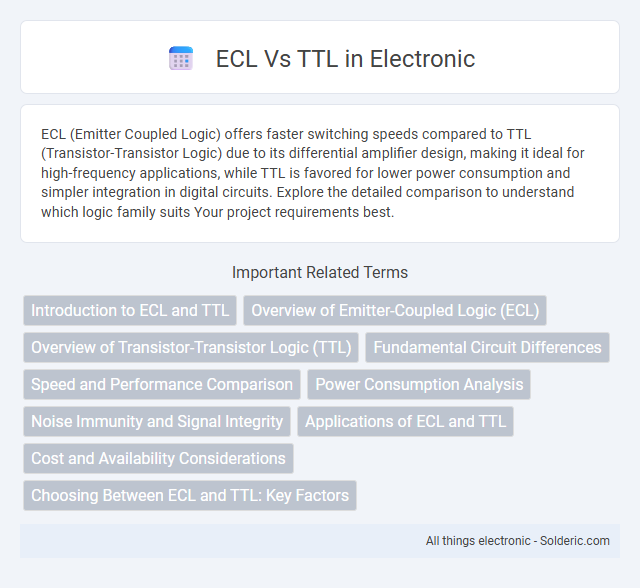ECL (Emitter Coupled Logic) offers faster switching speeds compared to TTL (Transistor-Transistor Logic) due to its differential amplifier design, making it ideal for high-frequency applications, while TTL is favored for lower power consumption and simpler integration in digital circuits. Explore the detailed comparison to understand which logic family suits Your project requirements best.
Comparison Table
| Feature | ECL (Emitter Coupled Logic) | TTL (Transistor-Transistor Logic) |
|---|---|---|
| Speed | Very high speed, typically up to several GHz | Moderate speed, typically up to hundreds of MHz |
| Power Consumption | High power consumption | Low to moderate power consumption |
| Voltage Levels | Negative logic levels (approximately -0.8 V to 0 V) | Positive logic levels (5 V standard) |
| Noise Margin | Lower noise margin due to small voltage swings | Higher noise margin |
| Output Type | Open emitter output | Totem-pole output |
| Fan-out | Typically lower fan-out (around 10) | Higher fan-out (up to 10) |
| Applications | High-speed computing, RF circuits | General purpose digital logic, microcontrollers |
| Complexity | More complex design and manufacturing | Simple and cost-effective design |
Introduction to ECL and TTL
Emitter-Coupled Logic (ECL) is a high-speed digital logic family known for its fast switching speeds and low propagation delay, commonly used in applications requiring rapid signal processing. Transistor-Transistor Logic (TTL) operates with bipolar junction transistors and is characterized by moderate speed, widespread availability, and ease of use in general-purpose digital circuits. ECL achieves faster operation by avoiding transistor saturation, whereas TTL uses saturation switching, impacting their respective performance and power consumption profiles.
Overview of Emitter-Coupled Logic (ECL)
Emitter-Coupled Logic (ECL) is a high-speed digital logic family that operates by steering current through differential transistor pairs, enabling faster switching times compared to Transistor-Transistor Logic (TTL). ECL circuits maintain a constant current flow, minimizing voltage swings and reducing delay, which makes them suitable for applications requiring high-frequency performance. The typical voltage levels in ECL are centered around -1.7 V, with a characteristic low noise margin but significantly higher speed than standard TTL circuits.
Overview of Transistor-Transistor Logic (TTL)
Transistor-Transistor Logic (TTL) is a widely used digital logic family known for its robustness, moderate speed, and low power consumption compared to Emitter-Coupled Logic (ECL). TTL circuits operate with voltage levels typically around 5V and feature transistor-based switching, making them ideal for general-purpose digital applications and microcontroller interfacing. Your choice between TTL and ECL depends on the need for speed, as TTL offers reliable performance with simpler design requirements, whereas ECL excels in high-speed computing environments.
Fundamental Circuit Differences
Emitter Coupled Logic (ECL) operates using differential amplifiers that switch transistors in the active region, enabling faster performance by avoiding transistor saturation common in Transistor-Transistor Logic (TTL). TTL circuits rely on saturated bipolar junction transistors that switch fully on or off, resulting in slower transition times compared to ECL's constant current and voltage-steady operation. The fundamental difference lies in ECL's use of current steering through differential pairs versus TTL's voltage switching with saturated transistors, directly impacting switching speed and power consumption profiles.
Speed and Performance Comparison
ECL (Emitter-Coupled Logic) outperforms TTL (Transistor-Transistor Logic) in speed, with typical propagation delays of around 0.3 to 0.5 nanoseconds compared to TTL's 10 to 20 nanoseconds, making ECL ideal for high-frequency applications. ECL achieves this superior performance by operating with transistors in the active region and avoiding saturation, reducing switching times and minimizing power supply noise. Despite higher power consumption, ECL's high-speed switching and low output voltage swing enable faster overall system performance compared to the slower, more power-efficient TTL technology.
Power Consumption Analysis
ECL (Emitter Coupled Logic) has higher power consumption compared to TTL (Transistor-Transistor Logic) due to its constant current flow, which results in greater heat dissipation even when idle. TTL circuits, on the other hand, consume power primarily during switching, making them more energy-efficient for low-frequency applications. Your choice between ECL and TTL should consider the trade-off between ECL's high-speed performance and TTL's lower power consumption requirements.
Noise Immunity and Signal Integrity
Emitter Coupled Logic (ECL) offers superior noise immunity compared to Transistor-Transistor Logic (TTL) due to its constant current operation and differential signaling, which reduces voltage noise margins and enhances signal stability. ECL's faster switching speeds contribute to better signal integrity by minimizing timing errors and jitter, critical in high-frequency applications where TTL's slower transitions can cause signal distortion. The low voltage swing in ECL circuits further improves immunity to electromagnetic interference, ensuring cleaner data transmission in noisy electronic environments.
Applications of ECL and TTL
ECL (Emitter Coupled Logic) is commonly used in high-speed applications such as telecommunications, supercomputers, and military radar systems due to its fast switching capabilities and low propagation delay. TTL (Transistor-Transistor Logic) finds widespread application in digital electronics, including microcontrollers, embedded systems, and simple logic circuits, thanks to its ease of use and lower power consumption compared to ECL. Your choice between ECL and TTL will depend on whether speed or power efficiency is the priority for your specific electronic design.
Cost and Availability Considerations
ECL (Emitter-Coupled Logic) devices generally incur higher costs compared to TTL (Transistor-Transistor Logic) due to their complex manufacturing process and specialized materials required for high-speed operation. TTL components are widely available and benefit from mass production, making them more affordable and easier to source for various applications. When selecting between ECL and TTL, budget constraints and supply chain accessibility play crucial roles, with ECL favored for speed-critical systems despite cost and availability limitations.
Choosing Between ECL and TTL: Key Factors
Choosing between Emitter-Coupled Logic (ECL) and Transistor-Transistor Logic (TTL) depends primarily on speed, power consumption, and noise margin requirements. ECL offers superior switching speeds exceeding 1 GHz, making it ideal for high-frequency applications, though it consumes significantly more power compared to TTL. TTL, with moderate speed up to 100 MHz and lower power dissipation, is preferred in cost-sensitive designs requiring robust noise immunity and simpler power supply conditions.
ECL vs TTL Infographic

 solderic.com
solderic.com